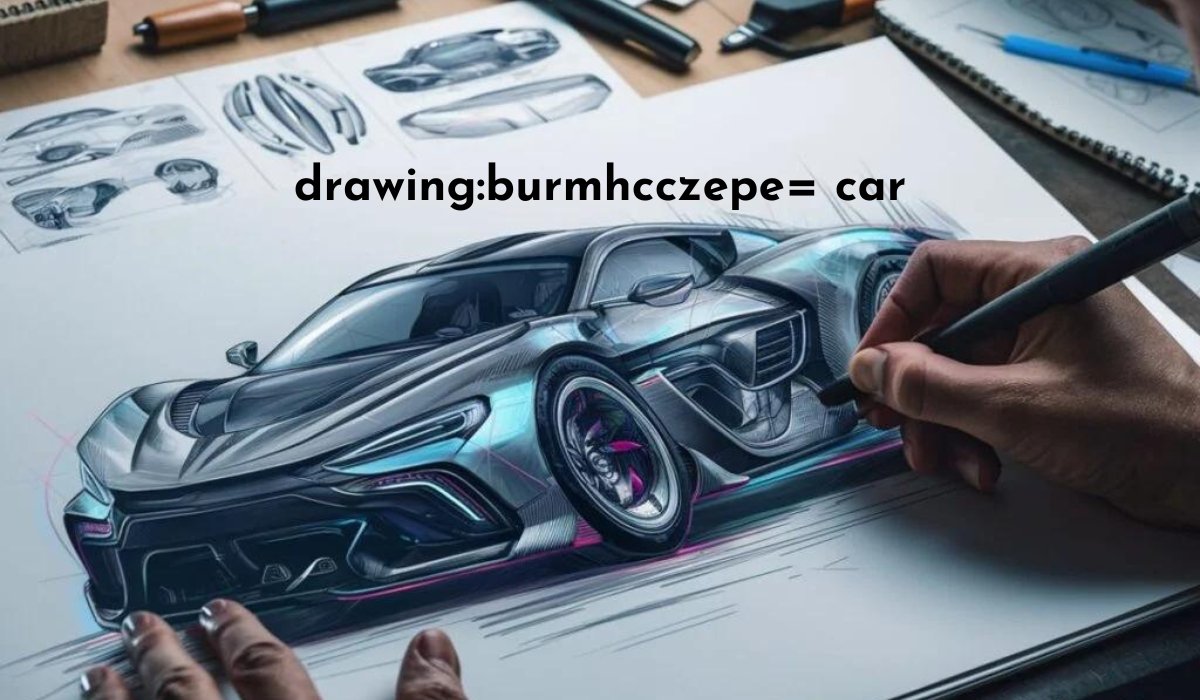Introduction
Drawing has long been a medium for artistic expression, allowing individuals to translate their perceptions and imaginations onto paper. Among the myriad subjects artists choose to portray, cars hold a particular fascination. The allure of drawing cars extends beyond their mechanical intricacies; it taps into a rich tapestry of culture, design, and personal expression. This guide delves into why cars are such an enticing subject for artists, the benefits of practicing car drawing, and provides a roadmap for those looking to master this unique form of artistic expression.
The Allure of drawing:burmhcczepe= car as an Artistic Subject
Cars represent a blend of technology, design, and human ingenuity, making them an appealing subject for artists. They are not just mechanical objects but symbols of personal freedom, status, and technological progress. Drawing cars allows artists to explore these themes while honing their skills in capturing complex forms and details. The allure lies in the challenge and satisfaction of rendering something both intricate and emblematic.
Benefits of Practicing Car Drawing
Engaging in car drawing offers several benefits:
- Observation Skills: Drawing cars necessitates keen observation. Artists must notice and replicate the subtleties of car design, from the curvature of a fender to the gleam of headlights. This enhances overall observational skills, which are applicable to various other drawing subjects.
- Patience: Car drawings, especially detailed ones, require significant patience. Artists must spend time perfecting each aspect, from the general shape to the finer details. This patience fosters a meticulous approach to other artistic endeavors.
- Detail: Cars are complex machines with numerous parts and textures. Learning to draw them involves mastering the representation of these details, which improves an artist’s ability to capture intricate elements in any drawing.
Guide’s Focus on Effective Strategies and Developing Personal Style
This guide aims to provide effective strategies for drawing cars and assist artists in developing their personal style. We will cover the fundamentals of car drawing, common errors, and techniques to enhance both creativity and skill.
Understanding Drawing: A Creative Journey
Drawing:burmhcczepe= car is a journey of exploration and observation. Initially, it might focus on technical accuracy, but as one progresses, it evolves into a form of creative expression. For car drawing, this journey involves understanding not just the technical aspects of vehicles but also their artistic potential.
Why Draw drawing:burmhcczepe= car ?
The appeal of drawing cars extends beyond their aesthetic appeal:
- Car Design for Artists: Cars feature sleek lines, dynamic shapes, and an array of textures, making them an exciting challenge for artists. Capturing these aspects can be both rewarding and educational.
- Cultural Significance: Cars often symbolize cultural values and technological advancements. They represent freedom, innovation, and status, all of which are compelling themes for artistic exploration.
- Captivating Nature of Car Drawings: Car drawings can be visually striking and full of energy. They often evoke a sense of movement and emotion, capturing the essence of the vehicle beyond its physical form.
Importance of Learning to Draw drawing:burmhcczepe= car
Learning to draw cars is not merely about replicating a physical object; it’s about developing a range of skills:
- Developing Fundamental Drawing Skills: Drawing cars requires a solid grasp of basic drawing principles such as proportions, perspective, and shading.
- Enhancing Observation and Analytical Abilities: The detailed nature of car drawings sharpens observation skills and improves analytical thinking as artists must break down complex shapes into manageable parts.
- Fostering Creativity and Career Opportunities: Car drawing can also be a gateway to careers in automotive design, illustration, and other related fields. It encourages creativity and innovation, qualities that are highly valued in these professions.
Avoiding Common Drawing Errors
Even experienced artists can encounter challenges when drawing cars. Here’s a comprehensive list of common mistakes and tips to overcome them:
- Proportional Errors: Cars have specific proportions, and misjudging these can lead to unrealistic representations. Use reference images and measurements to ensure accuracy.
- Perspective Issues: Cars are three-dimensional objects, and capturing them in perspective can be challenging. Practice perspective techniques to represent cars realistically.
- Detail Overload: While details are crucial, overloading the drawing with too many can clutter the composition. Focus on key details that enhance the drawing without overwhelming it.
- Inconsistent Lighting and Shading: Ensure that lighting and shading are consistent throughout the drawing to maintain a realistic appearance.
- Neglecting Background and Context: While the focus is often on the car, the background and context can significantly impact the drawing’s effectiveness. Incorporate these elements thoughtfully.
Basic Steps in Drawing a Car
To draw a car effectively, follow these basic steps:
- Research and Reference Gathering: Start by collecting reference images of the car you wish to draw. Analyze these images to understand the car’s shape, proportions, and details.
- Outlining the Basic Shape: Begin with simple shapes to outline the car’s general form. Focus on proportions and overall structure before delving into details.
- Adding Details: Gradually add details such as wheels, windows, and grille. Pay attention to the unique features of the car model you’re drawing.
- Shading and Texturing: Apply shading to give the car a three-dimensional appearance. Use different techniques to represent textures such as metallic surfaces and glass reflections.
- Final Touches and Refinements: Review your drawing and make any necessary adjustments. Refine details and ensure that all elements are cohesive.
Importance of Learning to Draw Cars
The ability to draw cars enhances various aspects of artistic development:
- Enhancing Creativity and Imagination: Car drawing stimulates creativity by encouraging artists to explore different designs, angles, and perspectives.
- Career Opportunities in Automotive Design: Proficiency in car drawing can open doors to careers in automotive design and illustration, where skills in capturing vehicle aesthetics are highly valued.
Grasping Car Anatomy and Perspective
Understanding car anatomy and perspective is crucial for realistic car drawing:
- Breaking Down Car Components: Study the various parts of a car, such as the chassis, wheels, and body. Understanding their functions and relationships will aid in accurate representation.
- Understanding Proportions and Angles: Cars have specific proportions and angles that must be accurately portrayed. Practice drawing cars from different viewpoints to master these aspects.
- Mastering Perspective Techniques: Learn perspective techniques to depict cars realistically in a three-dimensional space. This includes understanding vanishing points and horizon lines.
Essential Tools and Materials
Having the right tools and materials can make a significant difference in the quality of your car drawings:
- Recommended Drawing Tools and Materials: Use high-quality pencils, erasers, and paper suitable for detailed work. Graphite pencils with different hardness levels can help achieve various shading effects.
- Importance of Observing Real Car Surfaces: Studying real car surfaces and textures can enhance your understanding of how to represent these features in your drawings.
Finalizing a Car Drawing
Finalizing your car drawing involves several steps:
- Finalizing the Drawing: Review the overall composition and make any final adjustments. Ensure that all elements are well-defined and accurately represented.
- Fine-Tuning Details: Add any last-minute details that enhance the drawing’s realism and appeal.
- Signing the Artwork: Sign your drawing to mark it as your own. This also adds a professional touch.
- Sharing Your Artwork: Share your finished drawing with others to gain feedback and showcase your work. This can be done through social media, art communities, or exhibitions.
Advantages of Sketching Automobiles
Sketching automobiles offers several advantages:
- Developing Observational Skills: Sketching cars helps develop a keen eye for detail and improves observational skills.
- Cultivating Patience and Concentration: The detailed nature of car drawing fosters patience and concentration, qualities that benefit various aspects of life and work.
- Fostering Creativity and Innovation: Drawing cars encourages creative thinking and innovation, as artists explore different designs and concepts.
Improving Powers of Observation
The role of observation is central to drawing:
- Developing a Keen Eye for Detail: Cultivating a sharp eye for detail is essential for accurately rendering car features and achieving realism in drawings.
- Inspiring Car Drawing Examples: Studying the work of other artists can provide inspiration and insight into different techniques and styles.
Conclusion
Drawing:burmhcczepe= car is a rewarding artistic endeavor that combines technical skill with creative expression. By understanding the fundamentals, practicing regularly, and exploring different techniques, artists can enhance their skills and develop a unique style. The journey of mastering car drawing not only improves artistic abilities but also opens doors to various career opportunities and fosters a deeper appreciation for design and technology. Embrace the challenge, and let your creativity drive your passion for drawing cars.
You may also like: Discover the Mystical World of the Käämyäjä
Five Most Searched FAQs and Their Answers
Drawing cars improves observation skills, patience, attention to detail, and enhances creativity and potential career opportunities in automotive design.
Begin by researching car designs, outlining basic shapes, adding details, and practicing shading and texturing to gradually refine your skills.
Common mistakes include proportional errors, perspective issues, detail overload, inconsistent shading, and neglecting background context. Focus on accurate proportions and consistent details.
Essential tools include high-quality pencils, erasers, paper, and reference images of cars. Different pencil hardness levels help achieve various shading effects.
Improve your skills by studying car anatomy, practicing different perspectives, seeking feedback, and regularly drawing from real-life references and examples.










